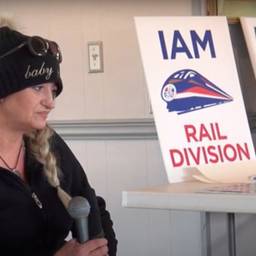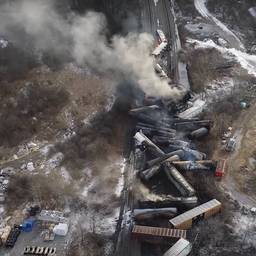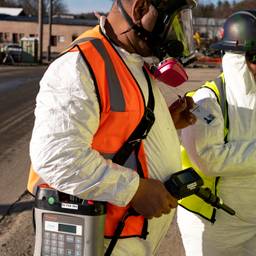Scenes From a Sacrifice Zone: South Baltimore Residents Fight Back Against Industrial Pollution
“I want everybody in this community to be able to breathe clean air, and it’s time to say enough’s enough.”
Maximillian Alvarez
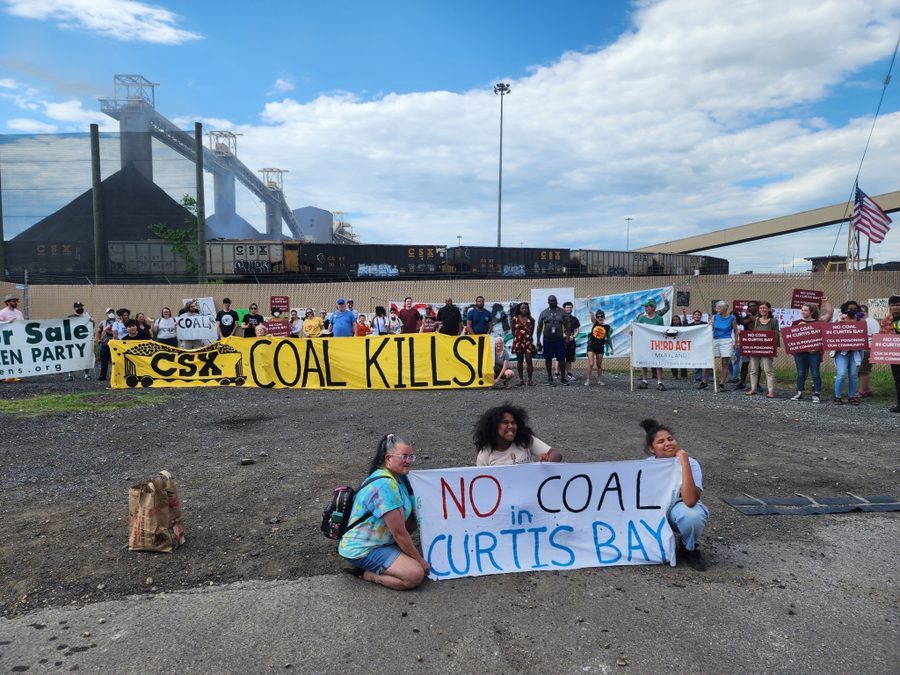
The explosion happened on Dec. 30, 2021, in the working-class South Baltimore neighborhood of Curtis Bay. At the coal plant building owned and operated by rail giant CSX Transportation, no more than a city block away from residents’ homes and local businesses, a buildup of methane gas inside one of CSX’s coal silo towers led to the thundering explosion.
“The explosion occurred at the coal transfer tower of the CSX Curtis Bay Pier in Curtis Bay, but the effects of the explosion were felt all over the city of Baltimore,” wrote Nicole Fabricant, a professor at Towson University and organizer with the South Baltimore Community Land Trust. “Windows exploded and glass shattered into the streets. Some residents described it as feeling like a ‘bomb’; others compared it to an ‘earthquake.’”
Angela “Angie” Shaneyfelt, a Curtis Bay resident who lives just a few blocks from where the explosion happened, was quarantining in her home with COVID at the time, standing in the living room, when she felt the blast. “You could feel it like a sonic boom,” she told me. Still in a bit of shock from the explosion, she quickly began to assess the situation: “I’m just looking around [and] I’m like, ‘Okay, the electric’s on. That’s fine. There’s no busted windows. That’s fine. There’s nobody shooting outside of my house…’”
Then she turned to her daughters, and her life changed:
I look at my kids and my one daughters is looking at me, she doesn’t know, she’s like looking for direction without saying anything. My other daughter mentally checked out. … She doesn’t do fireworks very well, even before this. She doesn’t do balloons very well. I had to tap her on her chin three times to say, ‘It’s okay, it’s okay.’ And when I looked in her eyes, she was not there. That’s the scariest thing that I’ve ever experienced in my life. I’ll take anything over that.
That, Shaneyfelt said, was when she decided to join other members of her community and get involved in the fight to hold CSX accountable—not just for the 2021 explosion but for decades of toxic pollution that have contributed to turning South Baltimore into an industrial “sacrifice zone.” And that’s what brought her and one of her daughters out on Monday, June 10, to join more than 50 of her neighbors and supporters from all over the city in a community-led march through the streets of Curtis Bay. “Hey, hey! Ho, ho! CSX has got to go!” marchers chanted.
With other locals watching from their porches, sidewalks and storefronts, the crowd moved steadily and purposefully from the Curtis Bay Recreation Center all the way up to the gates of the CSX terminal. There, they signed and delivered a giant eviction notice to CSX, a company that recorded more than $10 billion in gross profits last year.
“CSX,” the eviction notice read, “you are hereby required to vacate the premises. … Failure to vacate the premises will result in community backlash.”
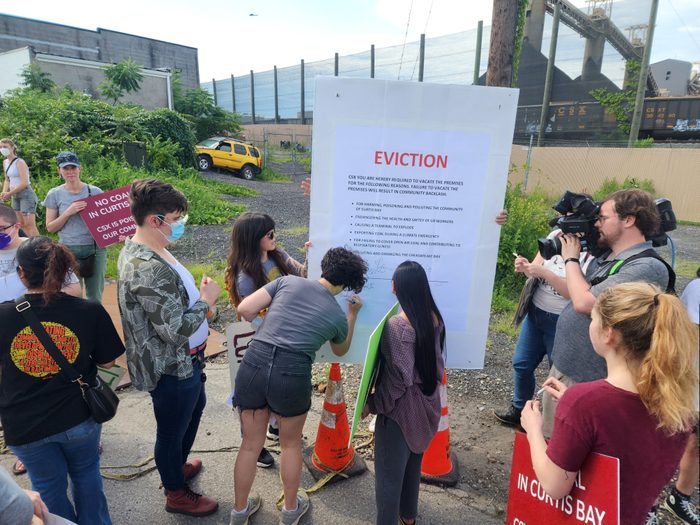
Long before the 2021 coal pier explosion pushed her to get actively involved in the fight to detoxify her community and hold polluters like CSX accountable, Shaneyfelt had still been dealing with the daily indignities of living in a sacrifice zone. For instance, she told me, “I have not opened my windows in 16 years.”
Like many of her neighbors, Shaneyfelt and her husband moved to Curtis Bay and stayed because that’s what they could afford. “We moved here because this is where our money took us.” But they quickly learned about all the other costs that come with living in an area poisoned by heavy industry and systematized government undersight (i.e., deregulation in practice). “We opened our windows the first year we were here,” she said. “That’s what you do on a nice day, no matter where you live in America or wherever. And then we realized that we [kept] having this black dust in our house on everything — on the carpet, on upholstery, all of it. You get tired of cleaning everything on a daily basis and wiping down everything. So it came down to just…we don’t open the windows anymore.”
But for the past two months, Shaneyfelt said, “the air felt different. It wasn’t as heavy as it had been for so long.” And she and her family did something they hadn’t done in 16 years: They opened the windows.
You could hear the genuine note of relief in her voice talking about it, quickly followed by a frustrated chuckle, because that relief was already gone — and the reason for it was kind of morbid to begin with. There’s been less coal dust in the air these past two months, because there’s been less coal traffic on the rails, because there’s been less coal traffic through the port, because the Francis Scott Key Bridge collapsed. In working-class America, Shaneyfelt and I somberly joked, one has to hope for something like a deadly, catastrophic bridge collapse to have the chance to open the windows and (cautiously) enjoy a breeze.
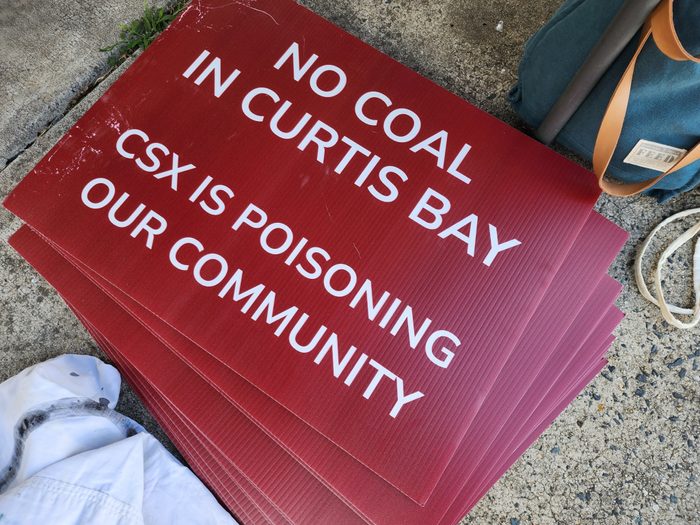
A soothing wind kicked up right about then as Shaneyfelt and I stood in the shade outside the recreation center before the press conference and march led by members of the community coalition Coal Free Curtis Bay and the South Baltimore Community Land Trust. It was a sunny, beautiful day, but there was something in the air. There’s always something in the air here. I watched Shaneyfelt squint mistrustfully at the invisible breeze, her daughter by her side.
I saw in Shaneyfelt and felt in myself the same eerie disquiet I’ve also seen in the faces of the chemically exposed residents of East Palestine, Ohio. And I was reminded of how impossible it is to quantify and articulate all the peace, happiness and security that is stolen from people when they can no longer trust the air they breathe or the water coming out of their faucets.
The physical toll that living in a sacrifice zone takes on people is perhaps only outweighed by the psychological toll of knowing you’re being sacrificed. When you and your family are feeling the daily effects of toxic exposure and no one appears to be doing anything about it, your circumstances don’t change, and only you and your neighbors are treating it like the emergency it is, you hit a breaking point. More accurately, you hit breaking point after breaking point. People living in and around East Palestine are there now, and they’ve been dealing with the toxic fallout from the Norfolk Southern train derailment since February 2023. South Baltimore residents are there now, too, and they’ve been dealing with this their whole lives.
David Jones, a resident who has lived in Curtis Bay for more than 35 years, recently told me on my podcast Working People about hitting one of those breaking points. “We were at a meeting the other night for the association,” he said, “and I’m not a very emotional guy, I really don’t try to show my emotions, but I lost it. I’m dealing with health issues for the first time in my life. I had COVID, and I have long COVID. Because of that, I just got shingles, and I’ve never been an unhealthy person. So to walk out into my neighborhood to get fresh air, and when I take a deep breath in, I’m choking and I’m wanting to throw up, and I can’t get that. … It’s disgusting.”
Still, Jones and his neighbors keep showing up, keep fighting. What other choice do they have? The only other options are sit and accept the unacceptable or move away from your home, and more are leaving — or seriously considering it — every year. Even if they do have to move away, Jones, Shaneyfelt and other residents all said, they would keep coming back to South Baltimore and keep fighting this fight. But you can see and hear that they are tired and frustrated.
“We’re tired of saying the same thing time and time again and no one doing nothing about it,” Jones said through a megaphone at the June 10 rally. He spoke to the crowd along with a group of his South Baltimore neighbors, including Shaneyfelt. “I want to be able to breathe clean air. I want my grandson to be able to breathe clean air. I want everybody in this community to be able to breathe clean air, and it’s time to say enough’s enough.”
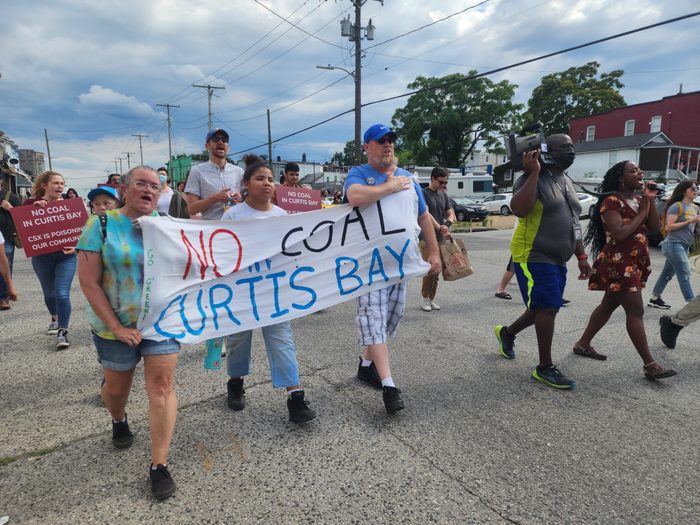
Angela Smothers, a lifelong resident of Mt. Winans in South Baltimore, gave a speech during the march. “I didn’t take my medication today on purpose,” said Smothers to the cameras, “because I want you guys to hear what I sound like. …It’s as if I’m having to get an extra wind to be able to speak, to breathe.”
Like Smothers, like Jones, the human beings living and dying here are the “evidence” of industrial pollution in South Baltimore — it’s etched on their bodies, plodding through their bloodstreams, caked in their lungs. And virtually everyone has stories of family, friends, and neighbors who have been affected.
“You are walking around wondering why everybody has breathing issues,” Tiffany Thompson, a Curtis Bay resident who was born and raised in Cherry Hill, told me on Working People, “wondering why these children are coming up with asthma when it’s not a family trait. …It’s sad to say, I know so many people walking around with oxygen tanks.”
While the situation residents in South Baltimore face is different from the one in and around East Palestine, there are some devastating similarities. The most glaring connection, of course, is that both of these public health emergencies have a railroad running right through them.
In their voracious pursuit to lower their operating ratios year after year, rail companies have cut costs and cut corners wherever they could, from routine layoffs to automation to reduced crew sizes — all while drastically expanding the length and tonnage of the trains. These changes have piled more work onto fewer workers who are given less time to do their jobs and bullied into silent submission by punitive managers and draconian attendance policies. Rail companies have invested tens of billions of dollars more over the past decade in stock buybacks and shareholder dividends than in rail maintenance. And while they’ve moved less freight, companies have jacked up prices and fees on captive shippers who rely on trains to transport their goods.
Workers warned this was untenable. It was a miracle that a catastrophic rail disaster, like the one that killed 47 people in Quebec in 2011, hadn’t happened here in the United States, they said. But something was going to give if the greed of these rail companies and their Wall Street shareholders wasn’t reined in. Then, in late November and early December of 2022, President Joe Biden and both parties in Congress conspired to prevent railroad workers from striking and forced a contract down their throats — a contract that did not, in any meaningful way, rein in the greedy practices that workers warned were putting them, the public and our supply chain at grave risk. It was never just about paid sick days for overworked railroaders. Two months later, Norfolk Southern’s “bomb train” derailed in East Palestine.
“Those of us who work in the rail industry knew it was only a matter of time before a disaster like this happened,” one veteran carman wrote for TRNN. “Unfortunately, we were ignored, and the people of East Palestine…are the ones paying for it.”
In interview after interview, like I’ve done with railroad workers, I also spoke with East Palestine residents about the unbearable pain inflicted on them and their families by these rail companies and the hell they’ve lived through since the train derailed in their backyard on Feb 3, 2023. They’ve told me about children scarred from the night of the derailment, suffering from PTSD when they hear fire engines pass; about the financially devastating situation they, their families and their contaminated town have been left in; about the medical bills piling up as they continue to suffer negative health effects from the toxins they were exposed to after Norfolk Southern made the catastrophic and unnecessary decision to “vent and burn” five carloads of hazardous chemicals. They have told me, like the residents of South Baltimore have, about the soul-scraping fear they feel watching their kids play outside and wondering if they will develop cancer from whatever is in the air, grass, and water.
“There’s not a night that I don’t go to bed and wonder, ‘Are my grandkids going to be able to have kids?” Stella Gamble explained on an episode of Working People that commemorated the one-year anniversary of the derailment. “When they’re 16 years old and they should be going to the prom and homecoming, are they going to be getting chemo for the cancer that they’re going to get from this?”
This is the cost of corporate greed, these are prices working people pay for Wall Street’s profits. “CSX and the other big Class One railroads have been making record profits now for a quarter century,” Ron Kaminkow of Railroad Workers United told In These Times. “They have done this by running roughshod over their workforce, their shippers, passengers, and trackside communities like Curtis Bay and East Palestine. It is time for rail unions to unite with community organizations, environmental groups, passenger advocates and others in order to counter these extremely powerful Fortune 500 corporations.”
Residents in East Palestine need help from organized labor, environmental justice groups, community organizations, etc., because they are fighting against impossible odds as so many have forgotten them and Norfolk Southern has tried to shut them up with a measly settlement and move on. And, like residents in other sacrifice zones who are fighting that fight, residents of East Palestine have come to the dismal conclusion that the conditions that have led to the sacrifice of their community are symptomatic of a problem that is much bigger than any one community or any one industrial catastrophe. “We now recognize this issue isn’t unique or solitary,” said Jess Conard, an East Palestine resident who has been thrust into the role of community advocate and now works as Appalachian director for Beyond Plastics, a project aimed at ending plastic pollution. “It’s systemic and vast.”
That is why, even though they’re exhausted and sick, South Baltimore residents like Jones, Smothers and Shaneyfelt marched in the streets earlier this summer along with supporters from around the city, all the way to the CSX coal terminal, a Baltimore PD chopper stalking overhead.
That is why coalitions of labor unions, railroad workers, environmental justice groups, community organizations, residents of other sacrifice zones, residents living near other rail lines and concerned citizens of all stripes are coming together in common struggle, to forge bonds of solidarity and mutual support between forgotten and downtrodden communities, from South Baltimore to East Palestine and beyond.
Working people living in sacrifice zones aren’t just fighting one polluter in their communities (and in areas like South Baltimore, there are many polluters). They are fighting against a vast state-business system that allows the pollution to happen, that protects Wall Street and corporate profits over people’s lives. They are fighting against a system that has normalized the sacrifice of whole communities, abandoned to live in conditions that threaten life itself; a system that issues operational permits to polluters and permits the polluters themselves to influence and shape the policies that are supposed to regulate them; a system that always puts the burden of proof on the people who are being harmed and places the largest financial, political and practical burdens on those same people when they try to prove they’re being poisoned, get legal recourse, or shape policy; and a system that inherently favors the rich and powerful over the rest of us, which is why companies like CSX can deny fault for decades while residents cry for help, deny the validity of any study saying otherwise, and force journalists like me to include statements like the one from CSX at the bottom of this article denying that there are any problems and affirming that they are, actually, the best of corporate citizens (even though I’ve seen with my own eyes the black swirling dust blowing off the uncovered CSX coal cars driving into Curtis Bay).
This is what sacrificed people like the residents of East Palestine and South Baltimore are up against, and they are not alone. And they cannot win these fights on their own either. They need help.
“We’re 4,500 poor people,” Gamble from East Palestine stated bluntly, “and we’re going to fight [a]…railroad” company worth billions of dollars? “Not gonna happen. It was a battle that was lost before we started it, but some of us still have to keep the fight on.”
Below is an excerpt from a statement sent to In These Times by the CSX media team:
CSX is committed to environmental compliance and strives to protect the environment and the safety and health of the public, our customers, and employees in all aspects of our operations.
CSX is proud of its nearly 200-year history in Baltimore and the Curtis Bay area. Our coal pier operations adhere to strict regulatory standards, and we regularly invest in technologies and practices that go above and beyond those standards set by federal and state governments, and maintain our own operational standards for environmental management, including those found in our environmental policy.
The data from Collaborative Investigation by MDE and others as analyzed by third-party experts indicates the community is in attainment with the U.S. Environmental Protection Agency National Ambient Air Quality Standards (NAAQS) for PM2.5 and PM10.
Further as required by our air permit, we installed a fence line air monitoring system along the perimeter of the property. Data from the fence line air monitoring is shared quarterly with the MDE and shows that the Curtis Bay facility is in compliance with the NAAQS for PM2.5 and PM10.
It’s our focus to continue constructive discussions with the Maryland Department of the Environment that can lead to a better understanding of our commitment to sustainability as well as collaborative efforts to address community concerns.
Maximillian Alvarez is editor-in-chief at the Real News Network and host of the podcast Working People, available at InTheseTimes.com. He is also the author of The Work of Living: Working People Talk About Their Lives and the Year the World Broke.
